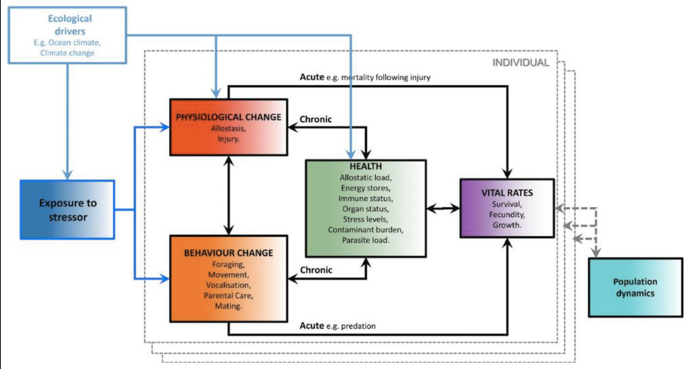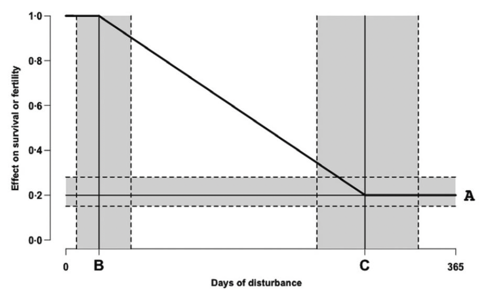Adapting the IPCOD Framework for Harbour Porpoises to Utilise a Dynamic Energy Budget Model in Modelling the Effects of Disturbance
This report outlines work taken to update the Interim Population Consequences of Disturbance framework (iPCoD) model to improve understanding of the effect of renewable energy installations on harbour porpoises.
Introduction
Background
The potential risk of injury and/or disturbance to marine mammals during construction of offshore renewable energy developments has been identified as a key consenting risk for projects in UK waters. Possible consequences of exposure to underwater noise from piling include disturbance that could cause marine mammals to either move away or change behaviour or suffer temporary and permanent hearing damage.
The iPCoD Framework
To address this, the Marine Directorate (formerly Marine Scotland Science) and Offshore Wind Directorate of Scottish Government and other UK partners have supported the development of the Interim Population Consequences of Disturbance framework (iPCoD). This development has been carried out by a team of researchers at the University of St Andrews, led by Prof. John Harwood (Harwood et al. 2014, King et al. 2015) (Figure 1). The original model framework was developed in the computing language R and released in 2013.
The model is primarily designed to help assess the impacts of disturbance and auditory injury in the form of permanent threshold shift (PTS) on marine mammal populations. The inputs include information about the management unit (MU) (for a given species and population) and the developments that could impact them (e.g. a calendar of days of activity, the numbers of animals impacted etc. – which come from external sources, such as impact assessments). The outputs provide the forecast of the population trajectory with and without the simulated disturbance and PTS.

One of the key areas that the scientific community working on PCoD has focussed on in recent years is the relationships between the amount of disturbance experienced by an individual and its vital rates (survival and the probability of giving birth). These relationships are often referred to as transfer functions. In iPCoD, expert elicitations were used to parameterize transfer functions with the form shown in Figure 2. Experts were asked to estimate the number of days of disturbance an animal can tolerate before a vital rate is affected, the number of days of disturbance required to cause the maximum effect of disturbance, and the confidence that had in the values they had provided.

In recent years, we have overseen a number of updates of the iPCoD , including new elicitations for the effect of disturbance on porpoise and seal species and auditory injury for all species, except minke whales (e.g. Booth and Heinis 2018, Booth et al. 2019). For any pathway or species not updated, the original elicitation outputs from 2012-2013 are used. The most recent expert elicitations in 2018 resulted in version 5.2 of the iPCoD model code, which is publicly available via SMRU Consulting[1]. We refer to this model as iPCoD v5.2 throughout this report.
2.1.2 Use of energetics in iPCoD
Disturbance can cause behavioural, physiological and health changes which can have subsequent effects on an individual's vital rates. In most cases, the effect of disturbance is mediated by the state of the individual (e.g. life history stage, exposure history, body condition), and the environment that the individual is in (e.g. resource availability). Dynamic bioenergetic models can be used to predict the changes in individual body condition (used as a proxy for overall health) that may occur in response to disturbance and infer how these changes may affect that individual's vital rates. The consequential demographic effects of disturbance can then be predicted by modelling multiple individuals (Pirotta et al. 2018). These bioenergetics models also consider the variation in an individual's energetic requirements during different life history stages and take into account the state of the environment the individual is in (e.g., resource density, presence of predators). Marine mammal species show a variety of life history strategies along a spectrum that extends from pure capital breeding (e.g., humpback whale, grey seal) through to the pure income breeding (e.g. harbour porpoise). The energetic consequences of disturbance will depend on the reproductive strategy adopted by a species and the life history stage of each individual in a population (i.e., the context in which disturbance occurs). For example, a lactating female in a resource poor environment would likely respond very differently to disturbance than a non-lactating female in a resource-rich environment (Hin et al. 2019). Bioenergetic models of this kind have been widely used to investigate the potential impacts of both natural and anthropogenic disturbance on marine mammals at both the individual and population level (see Pirotta et al. 2018, 2023 for reviews).
Between 2020 and 2022 SMRU Consulting developed Dynamic Energy Budget (DEB) models for the five iPCoD species (Harwood et al. 2020, Harwood et al. 2022). These reports describe the parameters that are used in the DEB model and provided suggested values for harbour seal (Phoca vitulina), grey seal (Halichoerus grypus), bottlenose dolphin (Tursiops truncatus), minke whale (Balaenoptera acutorostrata) and harbour porpoise (Phocoena phocoena) in the UK. For each species, the reports differentiate between parameter values that were obtained from the literature and those that were based on expert judgement. Harwood et al. (2022) also developed an approach to quantify the uncertainties associated with predictions of the effects of disturbance derived from DEB models and applied this to the harbour seal model. Chudzińska et al. (2024) extended this approach to the grey seal and harbour porpoise DEB models and used it to evaluate the potential population-level consequences of exposure to a number of hypothetical piling scenarios. We will use their approach in this project.
It should be recognised that predictions of the effects of disturbance based on the DEB approach are subject to three important "health warnings". First, this approach only evaluates the effect of changes in energy intake on vital rates. Disturbance may affect the same vital rates in other ways that are not accounted for by the DEB approach (i.e. see other pathways listed in the 'Health' box of Figure 1. Second, DEB models require values for a large number of parameters, but there is insufficient empirical information to estimate all of these values for any marine mammal species. Instead, most values are sourced from across the marine mammal and energetics literature on the assumption that they will be appropriate for all species. Finally, the models, as for iPCoD v5.2, require an estimate of the amount of foraging time that will be lost as a result of each day of disturbance. Chudzińska et al. (2024) demonstrate that predictions of the population-level effect of disturbance are strongly influenced by the magnitude of this value, however there are few direct estimates of the duration of disturbance for any marine mammal species. We, therefore, conducted a detailed consultation and literature search to obtain a plausible range of values for this parameter for the harbour porpoise and this is described in detail in section 5.2 4.2.
Contact
Email: ScotMER@gov.scot
There is a problem
Thanks for your feedback